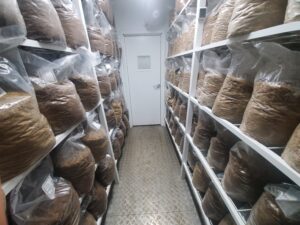Soil remediation is a critical environmental practice aimed at restoring or improving the quality of soil that has been contaminated or degraded by various pollutants, such as heavy metals, pesticides, petroleum products and industrial chemicals. The importance of soil remediation cannot be overstated due to its numerous ecological, agricultural, and human health benefits. Mycelium substrates, specifically mycoremediation, have emerged as a promising and sustainable approach to assist in soil remediation.
Here are some key points on the importance of soil remediation and how mycelium substrates can help:
- Environmental Protection: Contaminated soil can have severe adverse effects on the environment. It can lead to soil erosion, groundwater pollution, and harm to local ecosystems. Soil remediation helps mitigate these negative impacts, contributing to overall environmental protection and conservation efforts.
- Agricultural Productivity: Healthy soil is essential for agriculture, as it provides the necessary nutrients and support for plant growth. Soil contamination can lead to reduced crop yields and food safety concerns. Remediated soil can restore fertile ground for farming, ensuring food security and quality.
- Human Health: Contaminated soil can pose serious health risks to humans, especially if the contaminants leach into the water supply or are taken up by plants in the food chain. Soil remediation helps safeguard public health by reducing exposure to harmful substances.
- Biodiversity: Many soil-dwelling organisms, including microorganisms, insects, and plants, depend on a healthy soil environment. Soil remediation efforts aim to protect and restore these ecosystems, supporting biodiversity and ecological balance.
- Land Reclamation: Remediated soil can be repurposed for various land uses, including residential, commercial, and recreational purposes. This repurposing of land can revitalize urban areas and promote sustainable development.
Now, let’s explore how mycelium substrates plays a role in soil remediation, which FarmBox Foods customer BLH Farm has been doing since acquiring a Gourmet Mushroom Farm:
Mycoremediation: Mycoremediation is a bioremediation technique that employs fungal mycelium, the thread-like vegetative part of fungi, to break down or absorb contaminants in the soil. Mycelium has several properties that make it effective in soil remediation:
- Biodegradation: Mycelium can secrete enzymes that break down complex organic molecules, making them more easily metabolized by other microorganisms and reducing the toxicity of contaminants.
- Metal Accumulation: Some species of fungi have the ability to accumulate heavy metals in their mycelium. This can help to immobilize or concentrate metals, preventing them from leaching into groundwater or affecting plant growth.
- Soil Structure Improvement: Mycelium can also improve soil structure by binding soil particles together, increasing soil porosity, and enhancing water retention.
- Carbon Sequestration: As fungi grow and decompose organic matter, they contribute to carbon sequestration, which can help mitigate climate change.
- Low Environmental Impact: Mycoremediation is often considered an environmentally friendly approach because it typically requires minimal external inputs and doesn’t produce harmful byproducts.
While mycelium substrates offer promising solutions for soil remediation, it’s essential to note that their effectiveness depends on various factors, including the type and extent of contamination, the specific fungi species used, and environmental conditions. That being said, mycoremediation is often used in combination with other remediation techniques to achieve optimal results. Additionally, research and development in this field continue to expand our understanding of how fungi can be harnessed for sustainable soil remediation practices.
